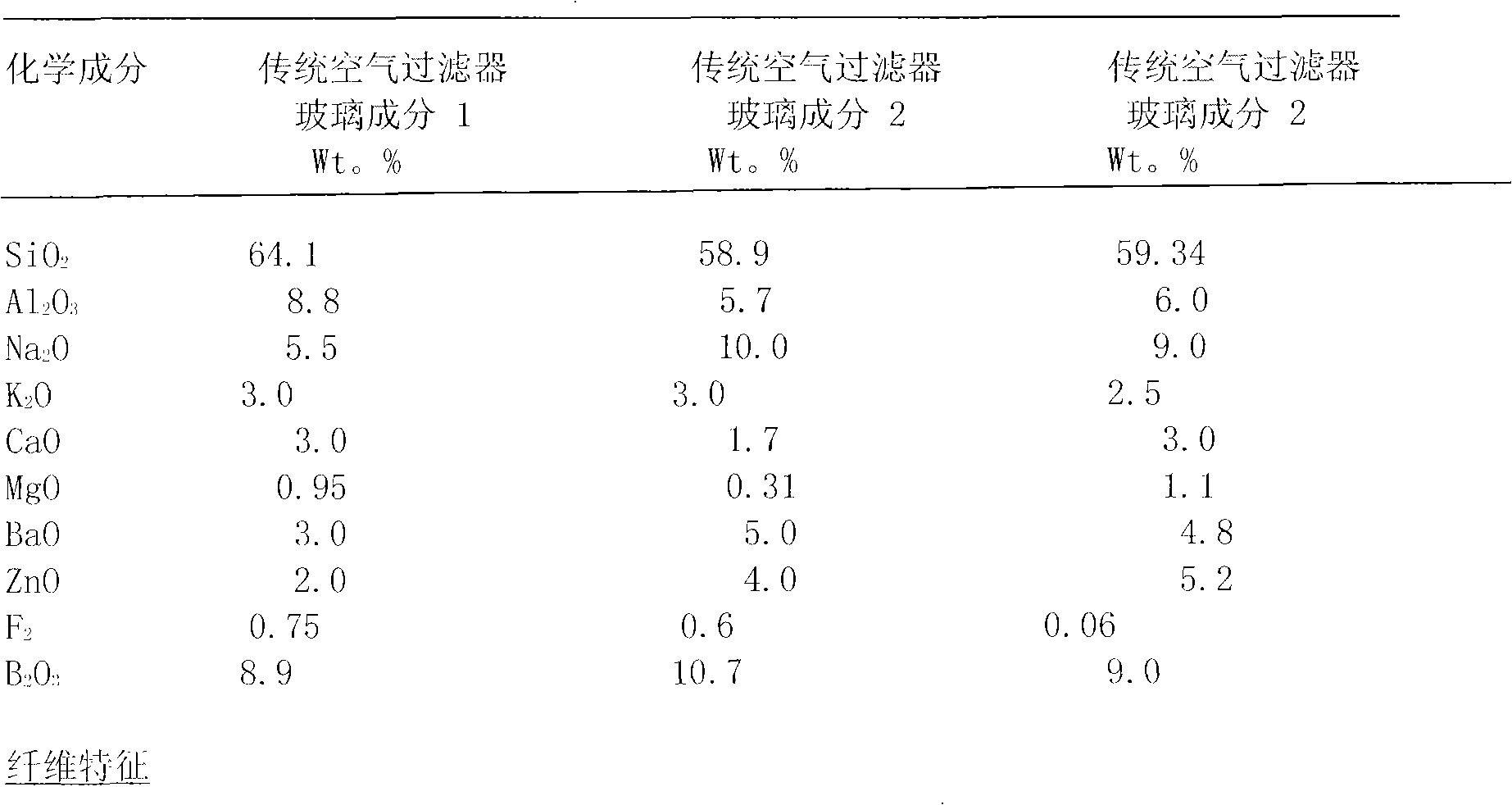Low-boron glass for glass fiber, glass fiber and manufacturing method of glass fiber
A glass fiber, boron glass technology, applied in the manufacture of glass fiber and glass fiber, low boron glass field, can solve the problem of producing fine glass fiber, achieve high moisture resistance, avoid boron pollution problems, and resist degradation.
- Summary
- Abstract
- Description
- Claims
- Application Information
AI Technical Summary
Problems solved by technology
Method used
Image
Examples
Embodiment 1
[0029] The low boron glass that is used for glass fiber of the present embodiment is characterized in that: by weight percent, be made up of following components: SiO 2 57%, Al 2 o 3 9%, Na 2 O 10%, K 2 O 5%, CaO 5%, MgO 2%, BaO 7.5%, ZnO 3%, Fe 2 o 3 0.1%, B 2 o 3 1%, F 0.4%;
[0030] Glass fiber is made by flame method, including melting process, primary fiber forming and drawing and blowing process, the specific steps are as follows:
[0031] a. Melting process: glass balls are placed into a high-temperature-resistant metal casing with multiple small holes at the bottom, and heated to melt the glass balls; the material of the high-temperature-resistant metal casing in this embodiment is platinum alloy;
[0032] b. Primary fiber forming: After the glass ball is melted, it flows out from the small hole at the bottom of the high-temperature resistant metal sleeve to form a primary fiber;
[0033] c. Wire drawing blowing process: the primary fiber is placed under a...
Embodiment 2
[0043]The low boron glass that is used for glass fiber of the present embodiment is characterized in that: by weight percent, be made up of following components: SiO 2 65%, Al 2 o 3 8.6%, Na 2 O 4%, K 2 O 1%, CaO 3%, MgO 0.2%, BaO 15%, ZnO 3%, B 2 o 3 0.1%, F 0.1%;
[0044] Glass fiber is made by flame method, including melting process, primary fiber forming and drawing and blowing process, the specific steps are as follows:
[0045] a. Melting process: glass balls are placed into a high-temperature-resistant metal casing with multiple small holes at the bottom, and heated to melt the glass balls; the material of the high-temperature-resistant metal casing in this embodiment is platinum alloy;
[0046] b. Primary fiber forming: After the glass ball is melted, it flows out from the small hole at the bottom of the high-temperature resistant metal sleeve to form a primary fiber;
[0047] c. Wire drawing blowing process: the primary fiber is placed under a high-speed fla...
Embodiment 3
[0057] The low boron glass that is used for glass fiber of the present embodiment is characterized in that: by weight percent, be made up of following components: SiO 2 63%, Al 2 o 3 7%, Na 2 O 8.4%, K 2 O 3.3%, CaO 3.3%, MgO 1.5%, BaO 9%, ZnO 3.7%, B 2 o 3 0.5%, F 0.3%
[0058] Glass fiber is made by flame method, including melting process, primary fiber forming and drawing and blowing process, the specific steps are as follows:
[0059] a. Melting process: glass balls are placed into a high-temperature-resistant metal casing with multiple small holes at the bottom, and heated to melt the glass balls; the material of the high-temperature-resistant metal casing in this embodiment is platinum alloy;
[0060] b. Primary fiber forming: After the glass ball is melted, it flows out from the small hole at the bottom of the high-temperature resistant metal sleeve to form a primary fiber;
[0061] c. Wire drawing blowing process: the primary fiber is placed under a high-spee...
PUM
| Property | Measurement | Unit |
|---|---|---|
| Diameter | aaaaa | aaaaa |
Abstract
Description
Claims
Application Information
 Login to View More
Login to View More - R&D
- Intellectual Property
- Life Sciences
- Materials
- Tech Scout
- Unparalleled Data Quality
- Higher Quality Content
- 60% Fewer Hallucinations
Browse by: Latest US Patents, China's latest patents, Technical Efficacy Thesaurus, Application Domain, Technology Topic, Popular Technical Reports.
© 2025 PatSnap. All rights reserved.Legal|Privacy policy|Modern Slavery Act Transparency Statement|Sitemap|About US| Contact US: help@patsnap.com


